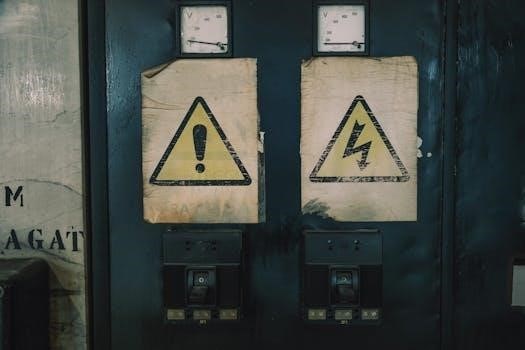
Welcome to the comprehensive guide for First Alert smoke detector manuals. These manuals are vital for understanding your alarm’s features, ensuring proper installation, and maintaining its effectiveness. They offer essential safety advice.
Purpose of the Manual
The primary purpose of a First Alert smoke detector manual is to provide users with clear and concise instructions on how to properly install, operate, and maintain their smoke alarm. These manuals serve as a crucial resource for understanding the specific features and functions of each model, ensuring optimal performance. They detail important safety precautions, recommended placement within the home, and how to interpret alarm signals. Furthermore, these documents outline troubleshooting steps and provide guidance on regular testing to confirm the device’s functionality. By adhering to the instructions within the manual, users can significantly enhance their safety and protection against fire hazards. These manuals are designed to be an integral part of your family’s safety plan, giving you precious time to escape in case of a fire.

Key Features of First Alert Smoke Detectors
First Alert smoke detectors boast combination smoke and carbon monoxide detection, intelligent sensing technology, and smart interconnect capabilities for enhanced home safety.
Combination Smoke and Carbon Monoxide Detection
Many First Alert models offer the advantage of combined smoke and carbon monoxide detection in a single unit. This dual-threat protection is essential for safeguarding your home against both fire and the silent danger of carbon monoxide poisoning. These combination alarms feature distinct sensors that are specifically engineered to detect both threats independently. The integrated design simplifies installation and maintenance, providing a comprehensive safety solution while reducing the number of devices required. This combination technology provides an early warning, giving you precious time to react to potential danger, which is an integral part of your family’s safety plan.
Intelligent Sensing Technology
First Alert smoke detectors often include intelligent sensing technology, designed to minimize nuisance alarms. This technology helps the detector differentiate between actual fire threats and common household occurrences like cooking fumes or steam. By employing advanced algorithms and sensor analysis, the alarm reduces the likelihood of false alarms, while still maintaining a high level of sensitivity to real fire emergencies. This improves user experience, making the alarm less disruptive and more reliable. This advanced feature ensures that the alarm is only activated when a genuine threat is detected, enhancing the overall effectiveness of your fire safety system and providing you with peace of mind.

Installation Guide
Proper installation is crucial for your First Alert smoke detector’s performance. This section will guide you through pre-installation checks and mounting procedures to ensure optimal safety.
Pre-Installation Checks
Before installing your First Alert smoke detector, verify that you have all necessary components. Inspect the detector for any visible damage. Ensure that you have the correct type of detector for your needs, such as ionization or photoelectric. Read the manual thoroughly to understand specific model requirements and limitations. Check your local building codes regarding smoke alarm placement. Confirm the power source is appropriate; some models use batteries, while others are hardwired. Plan the location considering recommended areas and places to avoid. Make sure you are familiar with the locking features, if applicable to your model. These steps ensure a smooth and effective setup.
Mounting Procedures
To mount your First Alert smoke detector, begin by selecting a suitable location on the ceiling or wall, following guidelines in your manual. Use the provided mounting bracket, securing it firmly with screws. If wiring is required, ensure the power is off before connecting wires. Attach the alarm to the mounting bracket, ensuring it is properly seated. For models with locking features, engage them if needed. Double-check that the detector is stable and correctly positioned. Avoid mounting near air vents or in areas with high humidity. Test the alarm after installation. This process guarantees optimal performance and safety.

Understanding Alarm Signals
First Alert smoke detectors use distinct horn patterns and indicator lights. These signals communicate different conditions, such as a fire, low battery, or malfunction, ensuring you can respond correctly.
Alarm Horn Patterns
First Alert smoke alarms utilize specific horn patterns to signal different events. A continuous, loud, three-beep pattern usually indicates a fire emergency, prompting immediate evacuation. The detectors also use a single beep every minute to signal a low battery condition, requiring prompt battery replacement. When the alarm is in test mode, it will sound a series of loud beeps, but this is not an emergency. Understanding these distinct audio cues is crucial for correctly interpreting the alarm’s message, so that you respond appropriately to the situation and know what action to take. Furthermore, a different pattern could indicate a carbon monoxide threat in combination models, emphasizing the importance of familiarity with your specific alarm’s manual. The alarm will also beep during end-of-life.
Indicator Lights Interpretation
First Alert smoke detectors use LED indicator lights to communicate their status. A constantly lit green LED typically signifies normal operation when the alarm is powered by AC. A flashing red LED, once per minute, often means the unit is operating on battery power. When the alarm sounds, the red LED will also flash rapidly. A lack of any light might indicate a loss of power, either from the main source or battery. Some alarms may use different light patterns to denote specific conditions. For instance, a different color or blinking sequence might signal low battery, a malfunction, or end-of-life. Check your particular model’s manual for detailed interpretations. Proper understanding of these light signals is essential for maintaining the alarm’s functionality.
Maintenance and Testing
Regular maintenance and testing are crucial for optimal performance of your First Alert smoke detector. Consistent checks ensure proper functionality and provide early fire warnings.
Weekly Testing Procedures
To ensure your First Alert smoke detector is functioning correctly, a weekly test is essential. Begin by locating the test button on your device. Press and hold this button until the alarm sounds. The alarm signal should be loud and clear. If the alarm does not sound, review the troubleshooting section of your specific model’s manual. Ensure all family members recognize the sound of the alarm. This practice reinforces the importance of fire safety. If the alarm is battery powered, check the battery compartment, to ensure proper connection. Regular testing can save lives.
Regular Maintenance Tips
Maintaining your First Alert smoke detector ensures its longevity and reliability. Dust accumulation can impair functionality; therefore, gently vacuum or wipe down the exterior monthly. Avoid using cleaning agents or solvents. Regularly check the battery compartment for corrosion and secure connections. Replace batteries annually or when indicated by a low battery chirp. Never paint over the smoke detector as it can obstruct its sensors. Ensure the alarm remains securely mounted. These practices are essential for optimal performance. Consult your manual for model-specific maintenance guidance. Regular care will maximize the protection offered by your device.

Troubleshooting
This section addresses common problems with First Alert smoke detectors. Learn how to diagnose issues, silence false alarms, and know when it’s time to replace your device for optimal safety.
Common Issues and Solutions
Frequent chirping often indicates a low battery; replace it immediately. False alarms can be caused by dust or steam; clean the detector gently. If the alarm doesn’t sound during testing, check the battery connections or power source. A latching alarm indicator might signal a previous event; clear it by pressing the test button. Ensure proper mounting to avoid malfunctions. If issues persist after these checks, consult the user manual. Remember, a faulty detector cannot ensure your safety. For persistent problems, contact First Alert support for guidance and possible replacement options.
When to Replace the Detector
First Alert smoke detectors have a limited lifespan and should be replaced after a certain period. If your detector is more than ten years old, it’s time for a new one, as the sensors can degrade over time. Replace immediately if it frequently malfunctions or fails tests, even after replacing the battery. Also, if the alarm has been exposed to excessive heat or has suffered physical damage, replacement is crucial. Always check the manufacturing date on the unit. Ignoring these signs can compromise your safety. Remember to dispose of the old unit according to local regulations.